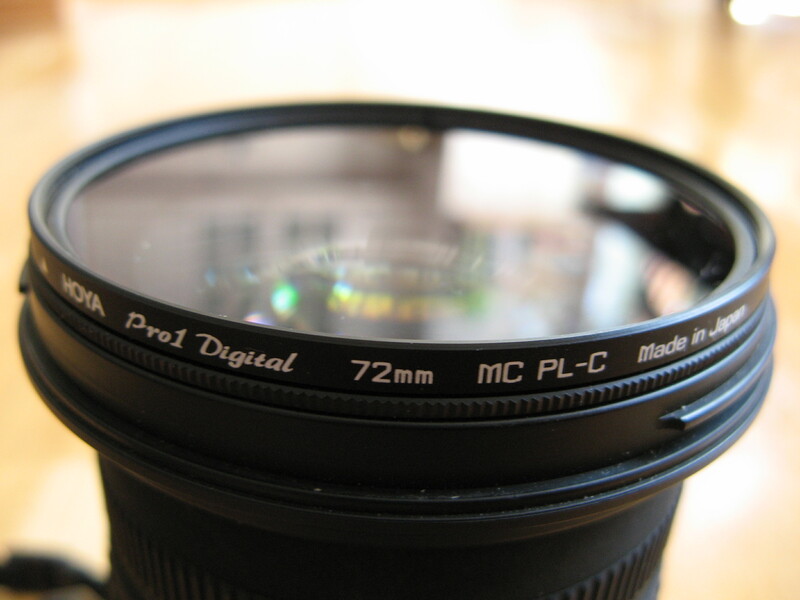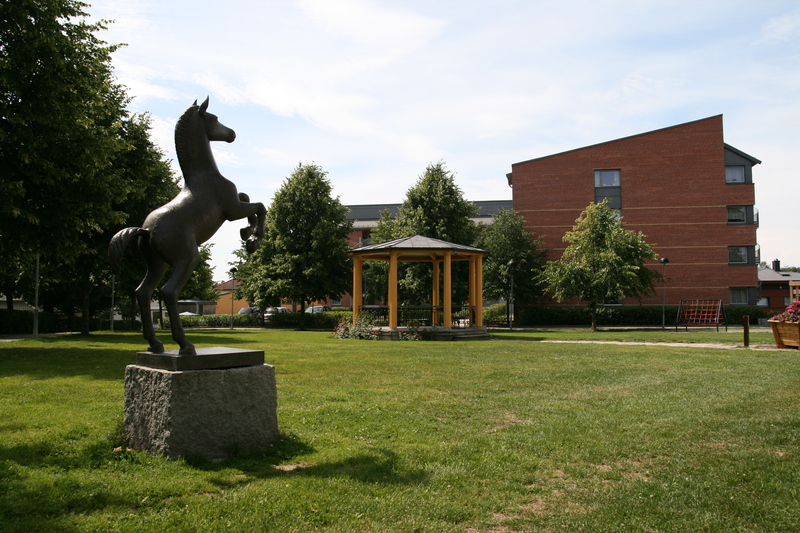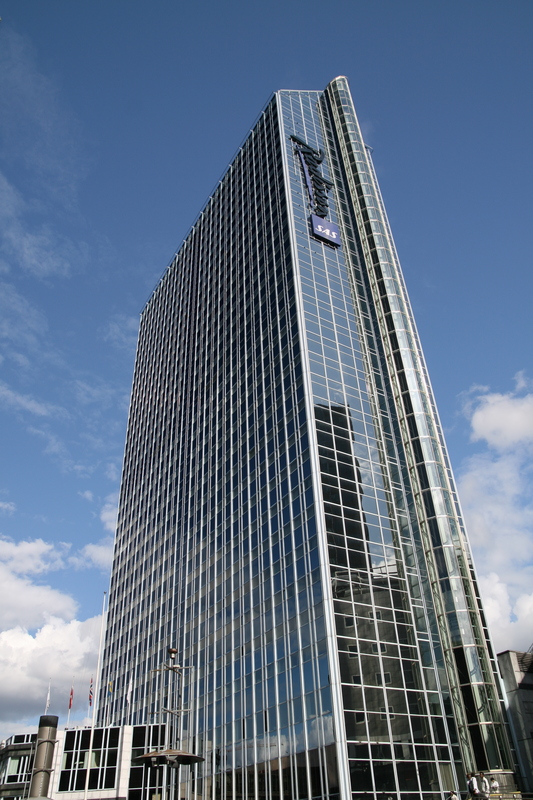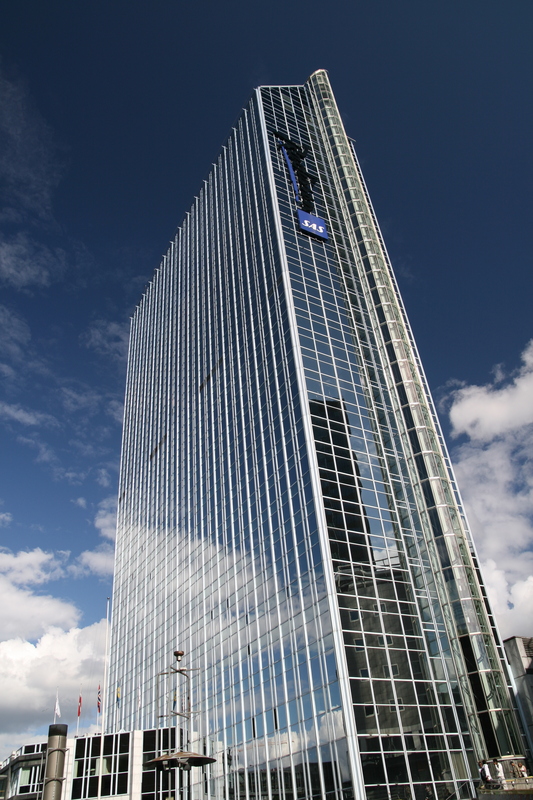Polarization filter

The filter |
After buying my DSLR camera I've developed symptoms of beginning camera-geekiness, and have on and off looked at all kinds of camera-related equipment, without actually buying anything. I was, however, given a polarization filter as a get well present by colleagues at work, and in return promised to write a blog entry about it. I actually find this an interesting subject to write about, and as I've now spent a few months playing with it, here we are.
The filter is basically a piece of glass which you can screw onto the front of the camera lens, filtering the light which goes through the lens to the sensor. (In the photo the filter is the topmost two rings.) There are all kinds of filters available, such as UV filters, gray filters, colour tint filters of various kinds, and so on on. Many of these are of dubious value in a digital world where Photoshop can do many of the same effects without the need to spend lots of time attaching and removing pieces of glass. A polarization filter, however, can do things that Photoshop cannot, which is why it's interesting.
The filter acts basically as a pair of sunglasses, blocking some light from entering the camera. Of course, the whole point of a DSLR camera is to be able to soak up more light, and so this may sound completely backwards. But not all light is created equal, and this can be exploited to get some interesting effects in photography. The next section explains the physics behind this. If you don't care, skip to the practical part below.
Polarized light

A sine wave |
Light is basically a wave, and often visualized as roughly a sine curve. If you imagine this wave moving through space you'll see that it's possible to turn (rotate) the wave so that it fluctuates straight up and down, sideways, or anything in between. Note that I'm not talking about changing the direction, just turning the wave sideways. This, the angle at which the light wave fluctuates, is the polarization of the light. Most light is not polarized, meaning that the light coming from some light source will have different random polarizations. In polarized light all the waves have the same polarization.
One example of this is IMAX 3D cinemas. These create a 3D effect by presenting a slightly different image to each of your two eyes, thus mimicking the 3D vision your eyes give you. Old-fashioned 3D comic books did the same thing, using one image printed in green and and another in red. Looking at these through spectacles with one green glass and one red glass would let each eye see a different image.
IMAX, however, does this in colour by using polarized light. The IMAX glasses are polarization filters, only letting through light with a particular polarization. The two glasses are turned different ways, thus each letting through a separate image and filtering away the other. If you hold the glasses out in front of you and look at the screen through them you can see the effect directly by turning the glasses 90 degrees, which will show you the two images joining up and separating in the glasses.
Another place you are likely to come across polarization filters is actually in some sunglasses, like mine. You can check yours by turning them as you look through them (when outdoors!). If nothing happens they're not polarizing.
Getting rid of reflections
Most light is not polarized, but light reflected off the surface of, say, water, metal, or glass does tend to be. This means that with a polarization filter you can remove the reflection, if you want to. This is useful in many situations, such as with sun glare from a building or water, taking photos of shiny objects, or through a window.
In bright sunlight the reflections off buildings and plants, etc tend to wash out the colours in these, and here the filter can be used to reduce the glare, thus deepening the colours and giving them more saturation.
For an example, look at the two images below, which are obviously not of enormous artistic merit, but which illustrate what I want to show. (Both are from the centre of Mysen in Norway.)

Without polarization |

With polarization |
In the two photos the lower one has removed the glare from the metal surface on the horse's back and tail. In addition, the colours in the grass particularly, but also in the brick building and the yellow pavilion are deeper with more saturation. The sky above the brick building is also made very slightly darker by the filter.
Making the sky blue
Now obviously the sky is blue already, but it quite often happens that the sky behind the object you're taking a photo of is over-exposed, turning it pale or even blowing it all the way out to white. With a polarization filter you can often filter out much of the light from the sky, turning the sky a deeper blue. Once you've taken a few photos this way (or worn polarizing sunglasses for a while) you start seeing this effect in photos in newspapers and commercials. A side benefit is that this tends to make the clouds look much more vivid and dramatic as well.
This time I'm using two photos of the Oslo Plaza hotel in Oslo city center to illustrate the point:

Without polarization |

With polarization |
Here the difference is quite striking, with the second photo being obviously much more dramatic. The most obvious effect is the darkening of the sky, but there are some other differences as well. Both photos are actually taken with the filter on, but I turned it 90 degrees after taking the first photo. The cloud reflection from the front of the building is almost gone in the first photo, showing removal of reflections. The cloud detail is also much better in the second photo, and the right-hand side of the building is darker in the second photo.
Conclusion
I started out not quite sure how useful this would actually be, but now I find myself reaching for the polarization filter whenever I'm taking photos in bright sunlight. Putting it on and taking it off does take some time, but I find that it's easily worth the effort. In use, it's incredibly simple. Just turn it with your finger while looking through the viewfinder until you get the effect you want. Sometimes it doesn't remove a reflection completely, or affect the sky noticeably, but usually it works just fine.
I have found, though, that using it with my polarizing sunglasses is not an option. I get weird optical effects at the best of times, and when the polarizations are 90 degrees to each other I see nothing at all, because all light is filtered out. On the other hand, I find that using the sunglasses (when not taking photos) give me a good idea of what the camera is going to see, so there are both good and bad sides to this.
One thing to note if you want to buy yourself a polarization filter: for a DSLR you need a circular one, all the sources I've read say. I didn't pick up why, but there you are.
Similar posts
Sigma 30mm F1.4 EX DC HSM
I didn't know much about lenses, having only ever used the one I bought with the camera
Read | 2009-07-17 21:14
tmphoto
You may have noticed that recently the photos used in this blogs have become links, which they weren't before
Read | 2007-09-15 19:08
New camera
On Tuesday I went to the local camera store and came out with a Canon EOS 400D, sold in the US under the idiotic name of Canon Digital Rebel XTi
Read | 2008-01-25 20:36
Comments
Tristan - 2008-07-27 07:12:11
A circular polarizing, versus linear polarizing, will allow your camera's metering and autofocus features (which are through the glass) to still function, as per wikipedia.
http://en.wikipedia.org/wiki/Photographic_filter#Polarizer
Mihai Albu - 2008-12-22 04:52:03
Recently I bought a polarization filter, I saw examples from you on the blog, are frumoase.skyscraper is more relevant compared with the first two pictures. I made myself a test, unfortunately we have not had a beautiful landscape for the test, but I had caught roofs blocks after rain, water and reflections of light interesting. You can see the http://www.albumihai.ro/post/2008/12/primul-test-cu-filtru-de-polarizare-circulara/ also have posted and the two pictures in RAW format. Maybe your readers are interested. Good luck